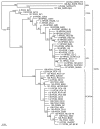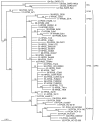Differential stepwise evolution of SARS coronavirus functional proteins in different host species
- PMID: 19261195
- PMCID: PMC2676248
- DOI: 10.1186/1471-2148-9-52
Differential stepwise evolution of SARS coronavirus functional proteins in different host species
Abstract
Background: SARS coronavirus (SARS-CoV) was identified as the etiological agent of SARS, and extensive investigations indicated that it originated from an animal source (probably bats) and was recently introduced into the human population via wildlife animals from wet markets in southern China. Previous studies revealed that the spike (S) protein of SARS had experienced adaptive evolution, but whether other functional proteins of SARS have undergone adaptive evolution is not known.
Results: We employed several methods to investigate selective pressure among different SARS-CoV groups representing different epidemic periods and hosts. Our results suggest that most functional proteins of SARS-CoV have experienced a stepwise adaptive evolutionary pathway. Similar to previous studies, the spike protein underwent strong positive selection in the early and middle phases, and became stabilized in the late phase. In addition, the replicase experienced positive selection only in human patients, whereas assembly proteins experienced positive selection mainly in the middle and late phases. No positive selection was found in any proteins of bat SARS-like-CoV. Furthermore, specific amino acid sites that may be the targets of positive selection in each group are identified.
Conclusion: This extensive evolutionary analysis revealed the stepwise evolution of different functional proteins of SARS-CoVs at different epidemic stages and different hosts. These results support the hypothesis that SARS-CoV originated from bats and that the spill over into civets and humans were more recent events.
Figures




Similar articles
-
Adaptive evolution of the spike gene of SARS coronavirus: changes in positively selected sites in different epidemic groups.BMC Microbiol. 2006 Oct 4;6:88. doi: 10.1186/1471-2180-6-88. BMC Microbiol. 2006. PMID: 17020602 Free PMC article.
-
Severe Acute Respiratory Syndrome (SARS) Coronavirus ORF8 Protein Is Acquired from SARS-Related Coronavirus from Greater Horseshoe Bats through Recombination.J Virol. 2015 Oct;89(20):10532-47. doi: 10.1128/JVI.01048-15. Epub 2015 Aug 12. J Virol. 2015. PMID: 26269185 Free PMC article.
-
Evolutionary Arms Race between Virus and Host Drives Genetic Diversity in Bat Severe Acute Respiratory Syndrome-Related Coronavirus Spike Genes.J Virol. 2020 Sep 29;94(20):e00902-20. doi: 10.1128/JVI.00902-20. Print 2020 Sep 29. J Virol. 2020. PMID: 32699095 Free PMC article.
-
Molecular epidemiology, evolution and phylogeny of SARS coronavirus.Infect Genet Evol. 2019 Jul;71:21-30. doi: 10.1016/j.meegid.2019.03.001. Epub 2019 Mar 4. Infect Genet Evol. 2019. PMID: 30844511 Free PMC article. Review.
-
A review of studies on animal reservoirs of the SARS coronavirus.Virus Res. 2008 Apr;133(1):74-87. doi: 10.1016/j.virusres.2007.03.012. Epub 2007 Apr 23. Virus Res. 2008. PMID: 17451830 Free PMC article. Review.
Cited by
-
Adaptive Evolution of the Fox Coronavirus Based on Genome-Wide Sequence Analysis.Biomed Res Int. 2022 Apr 13;2022:9627961. doi: 10.1155/2022/9627961. eCollection 2022. Biomed Res Int. 2022. PMID: 35463975 Free PMC article.
-
The Omic Insights on Unfolding Saga of COVID-19.Front Immunol. 2021 Oct 20;12:724914. doi: 10.3389/fimmu.2021.724914. eCollection 2021. Front Immunol. 2021. PMID: 34745097 Free PMC article. Review.
-
Evolution, Ecology, and Zoonotic Transmission of Betacoronaviruses: A Review.Front Vet Sci. 2021 May 20;8:644414. doi: 10.3389/fvets.2021.644414. eCollection 2021. Front Vet Sci. 2021. PMID: 34095271 Free PMC article. Review.
-
The evolutionary history of ACE2 usage within the coronavirus subgenus Sarbecovirus.Virus Evol. 2021 Feb 5;7(1):veab007. doi: 10.1093/ve/veab007. eCollection 2021 Jan. Virus Evol. 2021. PMID: 33754082 Free PMC article.
-
Variable routes to genomic and host adaptation among coronaviruses.J Evol Biol. 2021 Jun;34(6):924-936. doi: 10.1111/jeb.13771. Epub 2021 Mar 10. J Evol Biol. 2021. PMID: 33751699 Free PMC article.
References
Publication types
MeSH terms
Substances
LinkOut - more resources
Full Text Sources
Miscellaneous


